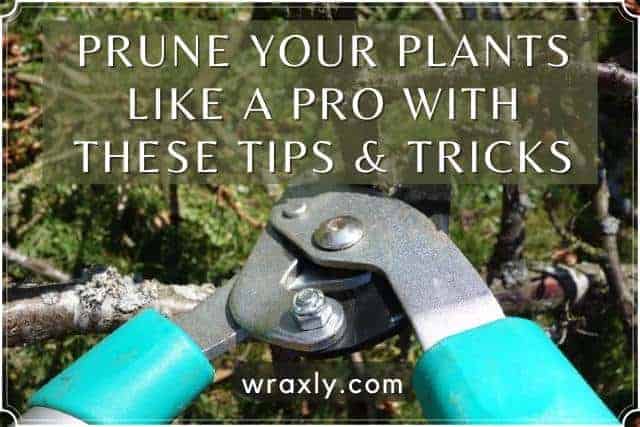Pruning is an essential gardening task, but many gardeners get it wrong. This article will help clarify the problem by covering five professional tips for plant pruning. We’ll also cover why pruning is so crucial and compare pruning to a similar gardening chore. Ready? Continue on to learn how to prune your plants!

5 Tips to Help You Prune Like a Pro
Although pruning is a vital form of plant maintenance, many gardeners lack fundamental knowledge in this area. To remedy that problem, we’ve identified the five most important pruning tips that you can begin using in your garden:
- Plan pruning for the right time of year
- Identify which parts of your plant to remove
- Make proper pruning cuts
- Know Your Pruning Goals
- Use Clean Pruning Tools
That list makes pruning sound like an incredibly simple task. However, there are plenty of details involved with each of those insights, which the sections below will explain.
Know the Ideal Pruning Time for Each of Your Plants
Each plant in your garden will have unique growing requirements. Often, those requirements include pruning during a specific time of year. In some cases, pruning outside that ideal timespan can do more harm than good.
Generally, the ideal times to prune most plants are in the late winter to early spring or towards the end of the growing season. Pruning in spring helps plants allocate the growing energy towards their most important branches throughout the following growing season. That pruning strategy can significantly improve the structure and form of your plants.
However, many plants should not receive pruning cuts in the late winter and early spring. Those plants typically have high volumes of sap flowing through their trunks and limbs during that time of year. Making a pruning cut at that time causes such plants to seep excessive amounts of sap, which can drastically weaken it. Fall pruning is often preferable for plants susceptible to this issue.
You should also pay close attention to the pruning needs of flowering plants. While some flowering species develop buds on new growth, others hold their buds on last season’s growth. Missing that distinction can cause you to an entire season’s worth of blooms if you prune at the wrong time.
The only way to know when to prune your plants is to study the distinct needs of each one you grow. Take a few moments to research the plant species you own and discover the prefeed pruning time for each one. Deciding the best pruning time is necessary before you begin the pruning process.
Identify which Parts of Your Plant to Remove
After you learn the best time of year to prune your plants, it’s time to decide which parts of the plant you will remove. While pruning for aesthetic goals is a worthy endeavor, there are some practical pruning cuts that you should address first. Most times you prune a plant, you should remove these parts:
- Any branch that is dead
- Any branch that is broken
- Any area of that plant that shows signs of disease
- Branches that cross and rub against one another
It will be easy to identify dead, broken, or diseased branches in most cases. However, pruning crossing branches is a bit more complex. The main issue here is deciding which of the crossing branches to cut off.
Crossing branches can damage each other and weaken the overall structure of your plant. When two branches cross, it is generally best to remove the branch that is growing back towards the center of the plant. Branches that grow within the center of the canopy are less likely to receive the sunlight they need and may die anyway.
Make Proper Pruning Cuts
Knowing which parts of the plant to remove is a foundational piece of knowledge that will guide your pruning efforts. However, that knowledge isn’t useful if you don’t make proper pruning cuts. Correct pruning often comes down to your pruning cut’s location. Locating your cuts in the wrong places can weaken your plants and cause the opposite of your intended pruning effect.
Where is the Best Place to Make a Pruning Cut?
The location of your pruning cut should be precise, regardless of what your pruning goals may be. Here is a general process that will help you determine that location:
- Identify the branch you wish to remove
- Follow the branch to the point where it meets a larger branch
- Notice the branch collar
- Cut the branch at the base while maintaining most of the branch collar
The branch collar is a slight bulge out of which a branch grows. This part of the plant contains special tissues that help it heal from your pruning cut. Removing the branch collar entirely makes it harder for your plants to recover. The longer recovery time leaves your plant vulnerable to rot and other complications.
While cutting off the collar is detrimental, leaving too much of the branch can have negative outcomes as well. Take care in selecting the location of your pruning cuts, making sure to remove the whole branch without removing the branch collar. Doing so will allow your plant to respond well to your pruning.
Recommended Pruning Sealer
Know Your Pruning Goals
Pruning is a functional way to preserve and improve a plant’s overall health. But once you meet those practical objectives, you can begin to consider other pruning goals. Here are some additional reasons why people prune their plants:
- Increase flowering
- Boost fruit production
- Enhance overall form and appearance
The tactics you use to achieve your pruning goals will vary by what your goals are and what plants you own. But after you meet the essential pruning needs of your plant, you are free to develop additional pruning goals as you please.
Developing pruning goals for your plants is partly a matter of preference. It’s up to you to decide what shapes you want to create with your plant’s growth habits. It’s also your decision to enhance fruiting and flowering capabilities among your plants. Regardless of which route you choose, the pruning goals you adopt will help develop a distinct character in your garden.
Use Sterile Pruning Tools
Our final professional pruning tip is to use sterile pruning tools every time you prune. Using dirty pruning tools can spread diseases between plants and can negate the positive outcomes you hoped to achieve through your pruning cuts. By contrast, sterile tools help prevent your pruning from causing undue stress to your plant.
Recommended Pruning Shears
How to Sterilize Pruning Tools
Sterile tools are a must-have item any time you want to prune your plants. However, those same tools will collect a lot of dirt and debris while you use them. As such, you’ll need a reliable method for cleaning those tools. Here is a simple process that can work well:
- Soak your pruning tools in warm water to remove debris
- Allow your pruning tools to dry
- Apply rubbing alcohol to your pruning tool blades
That straightforward process will kill any germs that may have the potential to afflict your plants. Ideally, you should use this process every time that you prune your plants. It’s also incredibly helpful to regularly sharpen your pruning tools as part of your cleaning routine. Sharp tools make for easier cuts that require far less effort on your part.
You may also be interested in… Popcorn Plant: The Surprising Facts You Need to Know
What is Pruning and Why is it Necessary?
The pruning process involves removing certain parts of a living plant. Pruning helps improve the health and the visual appeal of your favorite garden plants. You can have several objectives while pruning and numerous common mistakes you can make. However, neglecting to prune entirely is often the biggest mistake of all.
Plants that receive no pruning can become overgrown and encounter many issues, including disease and weak growth habits. Well-informed pruning habits help your plants avoid those complications, live their healthiest lives, and look their best throughout the season.
Recommended Electric Pruners
Pruning vs. Trimming and Why the Difference Matters
Many people mistakenly assume that pruning and trimming are the same. While pruning and trimming both involve removing parts of your plant, they are not the same process. Here is a quick description of the difference between the two:
- Pruning: Selectively removing branches with the goal of improving health and visual appeal
- Trimming: Shearing a plant’s branches and foliage to achieve a specific shape
Trimming is useful, especially for evergreen shrubs that respond well to shaping. However, trimming should not take the place of pruning in many cases.
While pruning is a highly selective process, trimming is often less accurate. The primary goal of trimming is to create interesting shapes. By contrast, pruning does much more to support your plants’ overall health and future growth while also considering aesthetics.
Final Thoughts on How to Prune Your Plants
Even though pruning is a necessary aspect of gardening, many gardeners fail to prune their plants correctly. Improper pruning is widespread and can cause significant problems for your tree. Fortunately, if you follow the tips in the article above, you’ll be ready to prune your plants like a pro in no time.

John Haryasz is a freelance writer and landscape designer. In the field of landscape architecture, he has contributed to many successful design projects throughout the country. As a writer, John specializes in creating captivating and informative web content. Through that work, he aims to share his design knowledge and promote engagement with the outdoor world.

![How to Water Indoor Plants [Plant Care 101]](https://wraxly.com/wp-content/uploads/2021/03/How-to-Water-Indoor-Plants-Plant-Care-101-1200-1024x576.webp)

![Growing Plants from Cuttings [A Simple Guide]](https://wraxly.com/wp-content/uploads/2021/03/Growing-Plants-from-Cuttings-A-Simple-Guide-1200-1024x576.webp)